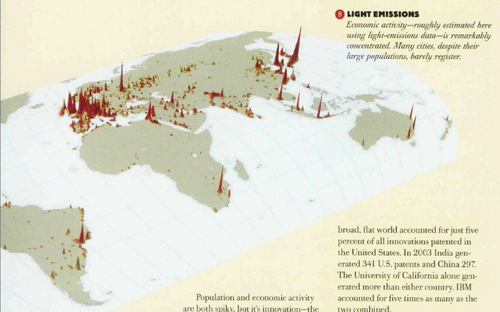The hallmark of a calculus course is epsilon-delta proofs. As one moves closer and closer to a point of interest (reducing δ, the distance from the point-of-interest), the phenomenon’s measure is bounded by something times ε, a linear error term. The bound comes from the continuity of the function, also defined in epsilon–delta terms.
So everything moves gradually, in a sense. There are no sudden jumps. But human affairs are characterized by jumping, leaping, gapping, sparking, snapping, exploding processes.
One studied example is stock prices. If terrible news hits about a public company, you won’t be able to sell your shares for the previous price minus epsilon. You’ll have to unload a gap or a yawn lower. Not that it was ever possible to trade in arbitrarily small δ intervals anyway. The smallest increment on the NYSE is $.01 (it used to be ⅛ of a dollar), which by infinitesimal standards is huge.
The Continuum
Speaking of infinitesimal standards, I need to digress for a few paragraphs so my point will make sense to all readers. Real numbers ℝ – any number you can construct with infinity decimal places, so essentially any number that most people consider a number at all – are thick, dense, an uncountable thicket. They are complete.
“The Reals” ℝ are made up of rational ℚ and irrational ℚᶜ numbers.
Rational numbers ℚ are ratios of regular counting numbers, 1, 2, 3, ℕ, etc., and their negatives −ℕ. However the rational part ℚ of the reals ℝ – the part that’s easy to conceive and talk about and imagine – is a negligible part of the real number line.
The irrational part ℚᶜ is further divided into algebraic 𝓐 and transcendental 𝓐ᶜ parts. Again the algebraic part 𝓐 is easier to explain and is, literally, negligible in size compared to the transcendental part.
Algebraic numbers 𝓐𝓐 are the x’s that solve various algebraic equations, like x²=2.
Whatever number x you square to get 2, is an algebraic number 𝓐. We invent a symbol √ and put it in front of the 2 symbol to express the number we’re talking about. Although there is no such symbol to express the number x that solves x² + x = 2 – square this number, then add itself to the result, and you get two – that is also an algebraic number.
Now add in all other finite-length equations with integer or fraction coefficients. That’s a lot of equations. Their solutions constitute the algebraic numbers 𝓐. But like I said above, 99% of the real numbers – those simple things you learned about in 3rd grade when they taught you the decimal system – are NOT IN THERE.
(99% of infinity, what am I talking about? It doesn’t make sense, I know, just work with me here.)

Transcendental
OK so now I have gotten to these hard-to-describe numbers called transcendental 𝓐ᶜ. The black part in the picture above. It took me a few paragraphs just to sloppily say what they are. If you have never thought about this issue before it might take you hours to wrap your head around them.
But it’s these transcendental numbers 𝓐ᶜ– can’t be assembled without an infinitely long equation – which essentially make calculus work. Calculus depends upon the real numbers ℝ and continuity therein, and without this thick, dense, impenetrable subset 𝓐ᶜ called transcendentals, its theorems would be unprovable and illegitimate.
I don’t know about you, but I haven’t seen any transcendental numbers around lately! Other than e and π, I mean. Despite transcendental numbers being the most numerous, only a few are known, most based around e and π. That’s right, these are the largest exclusive subset of the real numbers, and we don’t really know that many of them. We use them in proofs but not by name. Just knowing that they’re there ensures that calculus works.
But in the real world, you can’t buy e/3 eggs. That, among other reasons, means you can’t optimize – even in principle – a purchasing decision at the grocery using calculus. (Maybe you don’t think you would be using calculus anyway, but the economic theorists treat you like a gas particle dispersing in the room – and while the particle doesn’t think it’s using calculus to decide where to move, it obeys those laws. So they are relevant somewhere, contrary to the title of this post.)
Spiky
So calculus works in gas diffusion and solving various states of atoms / molecules via Schrödinger equations. But what about us people?


Here is a topographical picture of where people live. Notice that there is a lot of spikiness. Sudden jumps.
For a long time there’s no people because you’re in the middle of Nevada, and then – all of a sudden – Vegas! Holy cow there are people EVERYWHERE. Flowing in and out at a phenomenal rate. But there is zero flow and zero inhabitants just a few miles away. Molecules don’t behave like that.


Here is another picture – got it out of the same book, which my girlfriend is reading – of economic output by region.
Again, much spikiness. Not much calculus. Discontinuous outputs. Maybe that is how we are. Maybe calculus doesn’t work on us.



